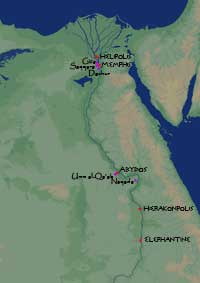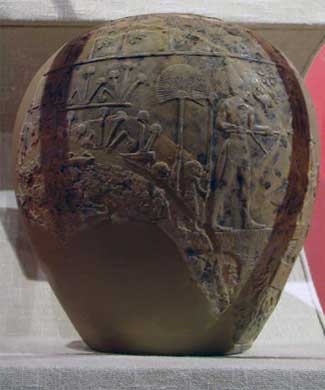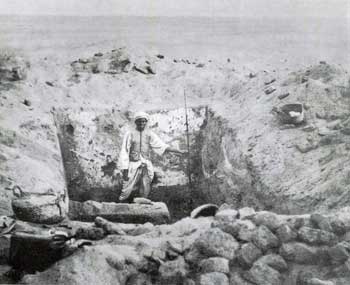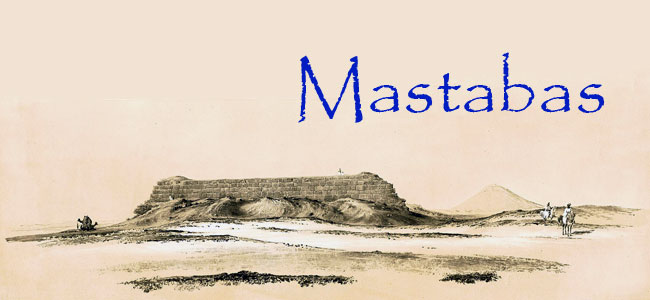
Predynastic Burial Practice
Preservation of the body was always vital element in ancient Egyptian burial practice—without it, the deceased had no chance at all of an afterlife. In prehistoric times a heap of sand, with perhaps a 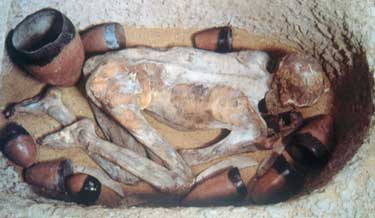 simple marker, was placed over the graves of the deceased who were laid out in burial pits at the edge of the desert. The heat and aridity of the natural environment was enough to prevent decay and a number of burials have survived intact (if somewhat dehydrated). In keeping with their view of the afterlife, the Egyptians placed offerings of food in distinctive pottery vessels around the deceased in order to sustain him (or her). In later times, these were replenished by the relatives through regular offerings at a chapel attached to the tomb. There is no direct evidence of that sort of thing in predynastic times but such a structure would have been made out of mud brick or reeds and its chances of survival would have been virtually nil.
simple marker, was placed over the graves of the deceased who were laid out in burial pits at the edge of the desert. The heat and aridity of the natural environment was enough to prevent decay and a number of burials have survived intact (if somewhat dehydrated). In keeping with their view of the afterlife, the Egyptians placed offerings of food in distinctive pottery vessels around the deceased in order to sustain him (or her). In later times, these were replenished by the relatives through regular offerings at a chapel attached to the tomb. There is no direct evidence of that sort of thing in predynastic times but such a structure would have been made out of mud brick or reeds and its chances of survival would have been virtually nil.
Towards the end of the Predynastic Period some of these graves, the burials of elite individuals, had become much more complex. The trend was to timber or brick-lined tombs made up of one or more rectangular rooms. Grave goods include ceremonial maces and cosmetic palettes carved out of various types of stone, stone bowls and large, carefully flaked flint knives. Painted pottery with

Naqada III Grave at Minshat Abu Omar in the Eastern Delta (©Dietrich Wildung)
scenes involving boats, people, animals and plants had replaced the black topped ware of earlier periods. The tomb would have been roofed over with wooden beams and packed earth or mud brick and then covered by some sort of superstructure. The availability and strength of the wooden beams went a along way to determining the dimensions of an individual room. Of course, none of this work could be done until after the funeral, which presented a huge problem as far as security was concerned.
The nature of these superstructures has proved an interesting problem for archaeologists—largely because of the scarcity of actual physical evidence. It is generally assumed that these early graves were covered with a mound of sand but, obviously, this is very difficult to prove since none have survived. A mound would have been very appropriate because the Egyptians believed that Life was first created on a Primeval Mound that emerged out of the waters of chaos, in much the same way as the plants sprang up after the annual inundation—an easy concept to grasp. In this particular context, the body would have been planted like a seed, to be reborn into 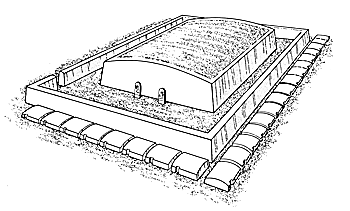 the Afterlife. Mounds were incorporated into the super-structures of a number of First Dynasty tombs but there is no literary evidence for such notions until near the end of the Old Kingdom. Traces of structures made of wood and reeds have been found elsewhere (at Hierakonpolis). Shown here (left) is an artist’s reconstruction of the tomb of Queen Merneith at Abydos. For a discussion of its accuracy, see below.
the Afterlife. Mounds were incorporated into the super-structures of a number of First Dynasty tombs but there is no literary evidence for such notions until near the end of the Old Kingdom. Traces of structures made of wood and reeds have been found elsewhere (at Hierakonpolis). Shown here (left) is an artist’s reconstruction of the tomb of Queen Merneith at Abydos. For a discussion of its accuracy, see below.
Early Dynastic tombs unearthed at Naqada, Saqqara and elsewhere have a very different appearance, they were built out of mud-brick and their panelled façades are believed to replicate the outside of an elite residence. This type of superstructure is known as a mastaba because of their resemblance to the benches that stand outside a traditional Egyptian house.
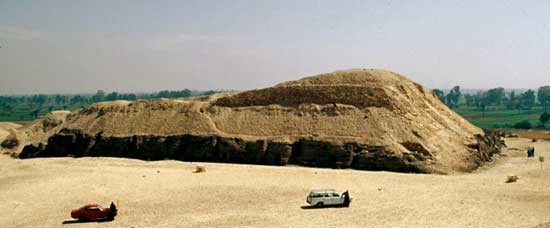
Old Kingdom Mastaba at Meidum
The distribution of these high status tombs indicates that, in Upper Egypt at any rate, a number of power centres had emerged the most important of which were Abydos, Naqada and Hierakonpolis. The general understanding among Egyptologists is that these towns, and perhaps Gebelein as well, were the seats of independent kingships eventually forged into one under the leadership of Abydos. 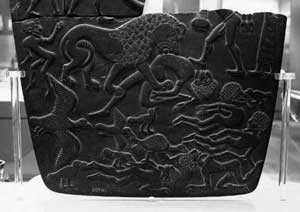 The extent to which force was involved is a matter of some debate but the iconography of the art, such as the Battlefield Palette (right) certainly supports the notion. Late in the Predynastic, tombs comparable to those in the south, can be found in the Delta—evidence of cultural dominance if not outright political control.
The extent to which force was involved is a matter of some debate but the iconography of the art, such as the Battlefield Palette (right) certainly supports the notion. Late in the Predynastic, tombs comparable to those in the south, can be found in the Delta—evidence of cultural dominance if not outright political control.
Some of the same motifs that were found on the painted pottery also appear on the walls of the roughly contemporary Tomb 100 at Hierakonpolis. Hierakonpolis, known to the Egyptians as Nekhen, was the home of Horus, the hawk god of kingship. For a time anyway it seems to have been the predominant power in Upper Egypt. The fact that later rulers adopted its god as their own and dedicated offerings to his sanctuary is testimony to its importance. The walls of the burial chamber were plastered and one side was painted with a scene depicting a number of typical reed boats, each with a pair of lightly built cabins. Presumably they are part of a sacred procession—the scene is strikingly similar to much later ones show a boat procession of the god or a pilgrimage to Abydos. Elsewhere there are a number of animals, wild and domestic, along with several
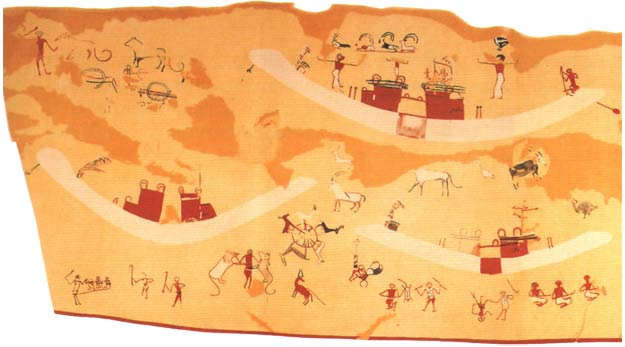
Copy of part of the Painted Decoration in Tomb 100
human figures. It is difficult to tell what all of the people are up to but one scene clearly shows a battle while another shows a scene of subjugation, possibly even a ritual slaughter of prisoners, a pose that becomes stereotypical of royal propaganda throughout Egyptian history (cf. the Narmer Palette on the previous page). Heraldic motifs such as the merry-go-round of antelopes (or whatever they are) and the man holding a pair of rampant lions by their throats are typically Mesopotamian, underlining the cosmopolitan nature of the early Egyptian state.
Suggested Reading
Emery, W. B. |
1961 |
Archaic Egypt |
O'Connor, David |
2009 |
Abydos. Egypt's First Pharaohs & the Cult of Osiris |
Spencer, A. J. |
1993 |
Early Egypt. The Rise of Civilization in the Nile Valley |
Wilkinson, Toby A. H. |
1999 |
Early Dynastic Egypt |

